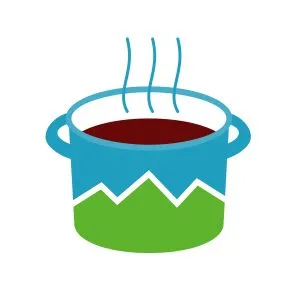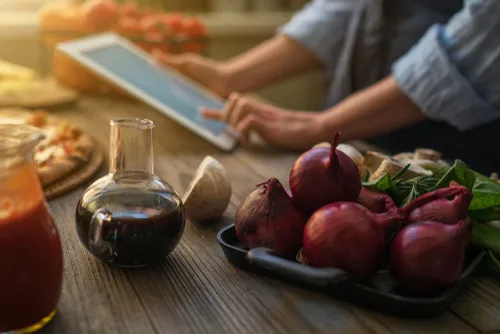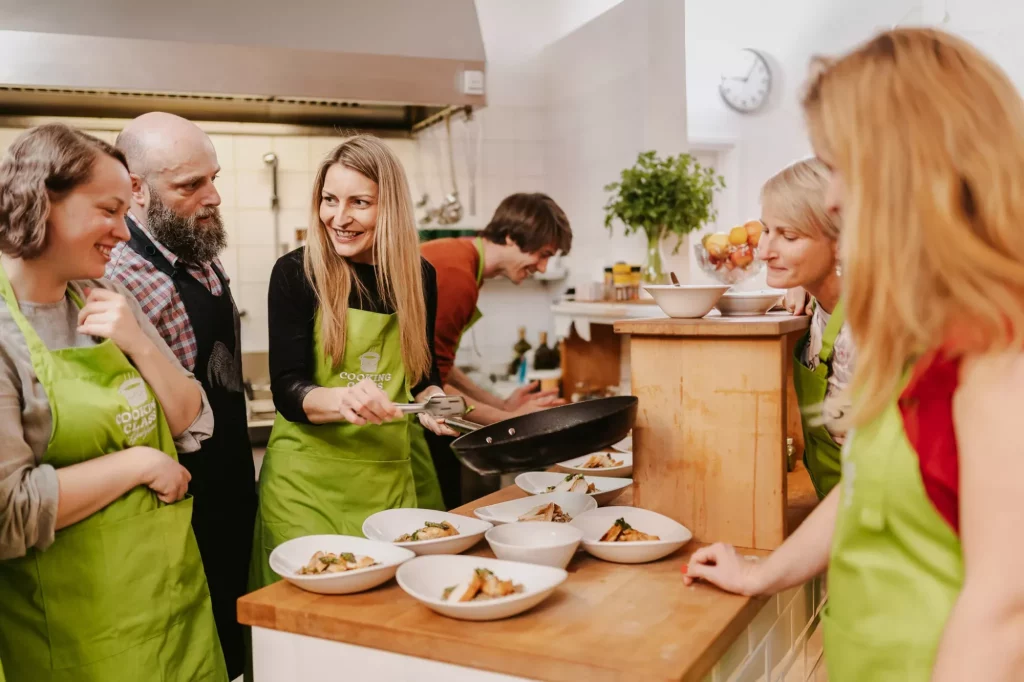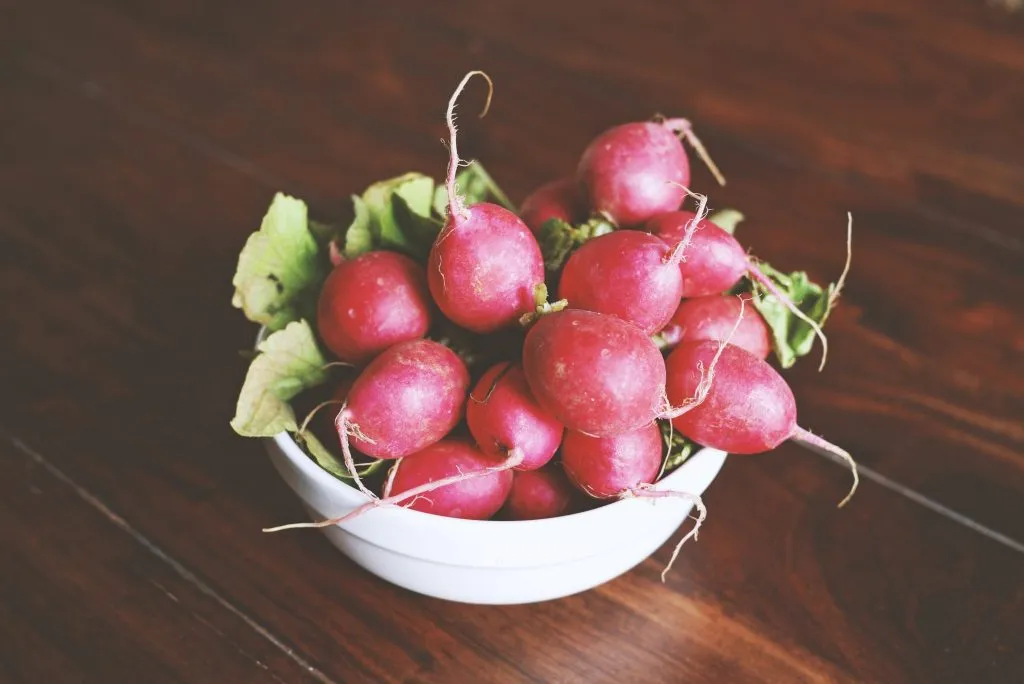Slovenia is proud of its wide range of traditional dishes, varied by different culinary regions. Due to the country’s small dimension, most of its traditional dishes were influenced by neighbouring countries, but nevertheless some dishes developed their own identity and a distinct taste. Some of those specialties, still popular today, are protected on European level.
Traditional Sunday lunch and more
Although the Slovenians might be known traditionalists at heart they also like to experiment, recently also in the culinary field, but if you ask any Slovene what a typical Sunday lunch looks like you will get a similar answer every time: Beef soup, roast beef and stir potatoes. But there are a lot more traditional dishes that have survived over the centuries. The famous Carniolan Sausage is still very popular as are dishes made from sour cabbage, such as jota, buckwheat kasha or štruklji. As for desserts, the two nationally treasures – walnut roll (potica) and Prekmurje layer cake (Prekmurska gibanica) make a grand entrance at every celebration or culinary event.
Learn to prepare Slovenian dishes with the chef
For all who would like a closer look into the Slovenian traditional culinary in Ljubljana, you can discover the amazing food it has to offer by being an active part of this culinary story – Cooking Class Ljubljana. If active participation isn’t your thing or in the days you are visiting Ljubljana would just like to relax, you can opt the Food Tour Ljubljana and get a taste of traditional Slovenian cuisine with this guided tour through the capital’s restaurants. You will learn about Slovenian traditions, rich cultural and cuisine heritage, eat like a local and enjoy the beautiful sights of the city while walking from one restaurant to another.
Recipes of 4 traditional Slovenian dishes
Jota with Carniolan sausage (Kranjska klobasa)
Jota is Slovenian popular winter fermented turnip or sauerkraut based stew. The dish originates from the Slovenian karst in the south western region. The great appeal of the stew or one pot dishes is in their practicality and jota is no exception. By making a huge amount of it at once, you can eat it also in the following day and also freeze it for later consumption when you won’t have time to cook a fresh meal.
What do you need?
For a big (about 8 litres) pot of soup, you need:
1-2 onions
3-4 cloves of garlic
2 spoons of olive oil
salt
3-4 medium size potatoes
½ kg of smoked pork ribs (or less if you prefer your food to be lighter)
800g can of brown beans or 300g of dry brown beans if you will cook it yourself
2 kg sour turnip or sauerkraut
1 teaspoon of Juniper berries
2-3 bay leafs
1 teaspoon of parsley (optional)
1 teaspoon of paprika (optional)
200ml of potato paste (optional)
Kranjska klobasa (optional)
How to prepare it?
Although you are cooking a one pot dish, you’ll however need at least two pots. One for the turnip or sauerkraut, one for the potatoes and another one if you will cook your beans instead of using the canned ones.
Cooking the brown beans
To cook your own beans you should let them soak overnight before cooking. Make sure you put them in enough water, because the beans will grow twice their size. Before cooking you should rinse the beans and put them to cook in the freshwater adding a few bay leaves.
Potatoes and sour vegetables
As you want our potatoes to be really soft cooked, you can’t cook them together with the turnip or sauerkraut. Acid prevents vegetables from softening during the cooking, so cook the potatoes and turnip or sauerkraut separately.
To the point
Chop the onions and garlic, stir them in the olive oil, then add peeled potatoes cut in chunks, add some salt and cover with water. Boil the potatoes till soft then mash them a little without pouring any water out. Add it to the turnip or sauerkraut which has been cooking separately.
One of the important things in making jota is finding a balance between animal fats and acidity. This recipe gives you an option to prepare it with or without Carniolan sausage. You can cook jota also without the sausage and add it as a side dish. You can also rinse the sour turnip or sauerkraut before cooking to remove some acidity in case you would like your jota less sour.
Then use a big pot and stir fry cut pork ribs (make sure to cut all the bones out) and Carniolian sausage (if we want it in the jota, otherwise cook it separately). Add sour turnip or sauerkraut (don’t rinse it) and cover it with water. Add bay leaves and juniper berries, wait till it boils, then cook it for about an hour. Afterwards add the potatoes, as described above.
When the potatoes are finally in the pot add all other ingredients, including the beans. If you are using canned beans, rinse them well with water before putting them into the pot. Stir it well together and cook for another 10 minutes.
Buckwheat kasha with mushrooms
The Slovenian woods and meadows are extremely rich with mushrooms. Because of that we have a wide variety of dishes based on mushrooms (soup, with meat, pasta, eggs, in risotto). Among them, buckwheat kasha has a prominent position, it is a pure harmony of flavours. It goes great with asparagus and you can always try your own version. If you would like to practice the recipe under a sharp chef’s eye, you can discover Cooking Class Ljubljana.
What do you need?
Buckwheat kasha (5 dag/per person for starter)
30 dag fresh mushrooms (chanterelle, porcini – king bolete, penny bun)
1 small onion
3 garlic
Oil or lard
Salt
Black pepper
Thyme
fresh parsley leaves
2 dcl vegetable soup stock
1 dcl white wine
water
Sour cream
Lemon
To the point
Saute the sliced onion in a pan with oil or lard until soft. Add chopped garlic and cook for 1 minute. Add sliced mushrooms and quickly fry. Next add buckwheat kasha and gradually add the water or soup stock and some dry white wine so the buckwheat absorbs all the liquid. The kasha is ready after more or less 15 min of cooking. Spice the kasha with thyme, pepper, salt and sliced parsley. As a final step mix sour cream, lemon juice and olive oil-this is easy and great sauce to lift up the flavours.
Štruklji
Štruklji is one of the most characteristic Slovenian foods, prepared in every geographical and gastronomic region of Slovenia, for both everyday and festive occasions. Štruklji are boiled, steamed, baked or fried rolls of thinly stretched or rolled wheat, buckwheat, potato or pasta dough with filling, served either as sweet or savoury dish. Tarragon štruklji are typically prepared in spring, cottage cheese štruklji in the summer, apple štruklji in the autumn, and walnut štruklji in winter. Over 80 different štruklji varieties are prepared in Slovenia and often served as a symbol of hospitality.
What do you need?
Dough:
20 dag white flour
1 egg
1 dcl warm water
3 tablespoon sunflower oil
pinch of salt
drop of vinegar or lemon juice
Sweet filling with Cottage Cheese:
3 tablespoon sour cream
25 dag cottage cheese
1 egg
3 tablespoon sugar
1 handful white breadcrumbs
Sweet filling with Cottage Cheese + Tarragon:
3 tablespoon sour cream
25 dag cottage cheese
1 egg
3 tablespoon sugar
1 handful white breadcrumbs
Tarragon
Sweet filling with apples:
5 apples-sliced
1 lemon
3 tablespoon sugar
1 handful white breadcrumbs
Cinnamon
STEP 1: Dough
Place the flour in a mixing bowl. Make a well in the flour and add all the ingredients. Blend and knead until the dough is smooth and elastic – at least 10 minutes. Leave it to rest for 30 minutes.
STEP 2: Sweet feeling with cottage cheese
Mix in cottage cheese, sour cream, egg, sugar and breadcrumbs. If you want more taste, add finely chopped tarragon or raisins (raisins are better if you soak them in rum for 30 minutes).
STEP 3:
After 30 minutes, roll the dough out (as thin as you can-so you can read newspaper through) on a lightly floured board into a rectangle about 12 inches by 18 inches. Spread the filling over the dough and roll it, starting at its long side, into a tight roll, much like a jelly roll.
STEP 4:
Place the roll on a clean white cloth or a double thickness of cheesecloth large enough to cover it. Wrap the roll in the cloth and tie the wrapping with string, sausage fashion. Put the roll into a circle and drop it into a large pot of boiling salted water. Boil for 20 minutes, then carefully lift it from the pot. Unwrap the roll and keep it warm.
STEP 5:
For the topping, sauté bread crumbs in butter until golden brown. Slice the Štruklji into pieces 2 inches thick and top with buttered crumbs.
Walnut roll – Potica
Walnut roll, potica or potizza is a Slovenian traditional walnut cake with the longest history. We are happy to share its recipe so you will be able to make it at your own home and enjoy every single bite of it.
Since we are talking about a dish with a long standing tradition and has been prepared by the whole family, we would invite you to enjoy making it in a friendly environment with a little help from a professional grandma.
As you can learn in the cooking class, the recipe was passed on from generation to generation and every house has its own diverse secret recipe. So, just add your secret ingredient and pass it on!
Let’s roll up the sleeves and put the hands in the yummy ingredients.
What do you need?
Ingredients for dough:
1 kg plain flour
30 g yeast
3-4 egg yolks
300 ml lukewarm milk
120 g butter
1 teaspoon salt
2 tablespoons sugar
butter for the mould
Ingredients for filling:
600–700 g walnuts
200 g honey
50 g sugar
100–200 ml milk
1 egg
ground cinnamon
rum or homemade brandy
Making the dough
The first thing you have to be careful about is to prepare the dough in a warm room. Start with mixing and stirring the flour with a teaspoon of salt, stir the yeast with a teaspoon of sugar, 2 tablespoons of flour and 200 ml of lukewarm milk and leave it in a warm place to rise.
Play with the dough. Make a hole in the middle of the flour, add whisked eggs, yeast, melted butter and sugar into the hole. While stirring add the lukewarm milk.
Beat the dough for 15 minutes or until bubbles appear and the dough separates from the bowl. Sprinkle some flour on the beaten dough, cover it with a cotton cloth and leave it in a warm place to rise.
Making the filling
To prepare the yummy filling, crush or grind the walnuts and pour some hot sweetened milk over them.
Heat up the honey until it liquefies. Add the honey and cinnamon to the walnuts and leave the filling to cool off. Add one or two eggs to the filling and mix thoroughly.
Putting it all together
Potizza is a rolled up dessert. Roll out the dough ½ cm thick and spread it with the warm filling. Roll tightly and put it in a buttered mould.
Leave the potica to rise slowly for up to 6h in a warm room, although it will also rise during baking. Before putting it in, preheat the oven to 180*C or 355*F, spread the potica with a whisked egg to make it shine – use a cooking brush.
Bake
It’s time to bake it for an hour. When you will see the golden crust, it means it’s baked.
Leave it in the mould for another 15 minutes to cool off. Sprinkle the potica with icing sugar if desired to make it look and taste even sweeter and more delicious.
Enjoy your Slovenian meal!










